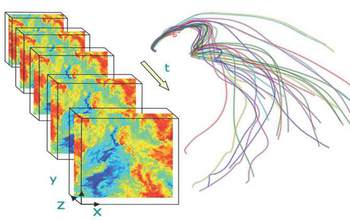Multimedia Gallery
Tracing the trajectories of particles (e.g. a contaminant) released under turbulent conditions.
This figure shows the trajectories of particles (e.g. a contaminant) released very closely together in an evolving turbulent field. It shows that the particle paths differ significantly. So when a sensor detects a signal, it has been "encoded" by the complex dynamics of turbulence and it must "decipher" this complex encoding to identify the source upstream.
Credit: Tamer Zaki and Charles Meneveau, Johns Hopkins University
Images credited to the National Science Foundation, a federal agency, are in the public domain. The images were created by employees of the United States Government as part of their official duties or prepared by contractors as "works for hire" for NSF. You may freely use NSF-credited images and, at your discretion, credit NSF with a "Courtesy: National Science Foundation" notation.
Additional information about general usage can be found in Conditions.
Also Available:
Download the high-resolution JPG version of the image. (49.4 KB)
Use your mouse to right-click (Mac users may need to Ctrl-click) the link above and choose the option that will save the file or target to your computer.
Related story: New U.S.-Japan collaborations bring Big Data approaches to disaster response



